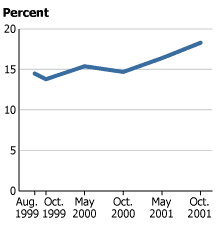
Argentina's Economic Crisis May Affect Migration Trends
(January 2002) The current economic crisis in Argentina is almost certain to affect migration patterns in Latin America. Historically a relatively wealthy nation, Argentina has long been a magnet for workers from its poorer neighbors. International organizations monitoring labor and migration trends have noted that while most Latin American migrants head to the United States, many have also sought out opportunities in Argentina, Brazil, Mexico, and Venezuela.
In its 2000 annual report, the Inter-American Commission on Human Rights said that within South America, Argentina and Venezuela have attracted the largest numbers of migrants. Argentina, which is second only to Brazil in size and population in South America, is estimated to have almost 2 million immigrants, more than half of them from Latin America. They come mainly from Chile, Bolivia, Paraguay, Brazil, and Uruguay, says the Commission, an arm of the Organization of American States. These immigrants have supplied labor mainly within the country’s informal sector and have included domestic workers, street vendors, and unregulated construction workers.
At the same time, with Argentina’s unemployment rates currently estimated at more than 18 percent, Argentines themselves are increasingly seeking opportunities elsewhere. A country of about 37 million that in earlier times attracted vast numbers of Europeans mainly from Italy and Spain, Argentina is home to several million people who are entitled to Spanish and Italian nationality.
“The desire to immigrate to Spain and Italy has become a veritable phenomenon in Argentina, as hundreds of people queue up every day at the Spanish and Italian consular offices,” says a 2001 edition of the U.S.-based Migration News. The paper has also pointed out that the Italian embassy in Buenos Aires granted more than 12,000 passports to Argentines of proven Italian origin in 2000.
While the new government of President Eduardo Duhalde has yet to set forth a definitive plan for coping with the country’s economic crisis, further delays in reducing unemployment are likely to result in additional emigration and possibly in a crackdown against illegal immigration. Such a crackdown could have a ripple effect in neighboring economies as migrants seek employment back home.
Unemployment Rates in Argentina

Source: Argentine National Institute of Statistics and Census (INDEC) (www.indec.mecon.ar, accessed Jan. 10, 2002).
Other Population Measures in Argentina
Population (mid-2001): 37.5 million
Average number of children per woman: 2.6
Annual number of deaths of children under age 1, per 1,000 live births: 19.1
Life expectancy at birth: 73 years
Percent urban: 90%
Source: Carl Haub and Diana Cornelius, 2001 World Population Data Sheet (Washington, DC: PRB, 2001).
Yvette Collymore is senior editor at the Population Reference Bureau.
